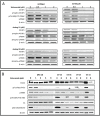Niclosamide and its analogs are potent inhibitors of Wnt/β-catenin, mTOR and STAT3 signaling in ovarian cancer
- PMID: 27888804
- PMCID: PMC5349955
- DOI: 10.18632/oncotarget.13466
Niclosamide and its analogs are potent inhibitors of Wnt/β-catenin, mTOR and STAT3 signaling in ovarian cancer
Erratum in
-
Correction: Niclosamide and its analogs are potent inhibitors of Wnt/β-catenin, mTOR and STAT3 signaling in ovarian cancer.Oncotarget. 2018 Apr 10;9(27):19459. doi: 10.18632/oncotarget.25151. eCollection 2018 Apr 10. Oncotarget. 2018. PMID: 29721216 Free PMC article.
Abstract
Epithelial ovarian cancer (EOC) is the leading cause of gynecologic cancer mortality worldwide. Platinum-based therapy is the standard first line treatment and while most patients initially respond, resistance to chemotherapy usually arises. Major signaling pathways frequently upregulated in chemoresistant cells and important in the maintenance of cancer stem cells (CSCs) include Wnt/β-catenin, mTOR, and STAT3. The major objective of our study was to investigate the treatment of ovarian cancer with targeted agents that inhibit these three pathways. Here we demonstrate that niclosamide, a salicylamide derivative, and two synthetically manufactured niclosamide analogs (analog 11 and 32) caused significant inhibition of proliferation of two chemoresistant ovarian cancer cell lines (A2780cp20 and SKOV3Trip2), tumorspheres isolated from the ascites of EOC patients, and cells from a chemoresistant patient-derived xenograft (PDX). This work shows that all three agents significantly decreased the expression of proteins in the Wnt/β-catenin, mTOR and STAT3 pathways and preferentially targeted cells that expressed the ovarian CSC surface protein CD133. It also illustrates the potential of drug repurposing for chemoresistant EOC and can serve as a basis for pathway-oriented in vivo studies.
Keywords: Wnt pathway; cancer stem cells; chemoresistance; ovarian cancer; targeted therapy.
Conflict of interest statement
Authors declare no potential conflicts of interests.
Figures





References
-
- Zhou J, Wulfkuhle J, Zhang H, Gu P, Yang Y, Deng J, Margolick JB, Liotta LA, Petricoin E, 3rd, Zhang Y. Activation of the PTEN/mTOR/STAT3 pathway in breast cancer stem-like cells is required for viability and maintenance. Proc Natl Acad Sci U S A. 2007;104:16158–63. doi: 10.1073/pnas.0702596104. - DOI - PMC - PubMed
MeSH terms
Substances
Grants and funding
LinkOut - more resources
Full Text Sources
Other Literature Sources
Medical
Molecular Biology Databases
Research Materials
Miscellaneous

